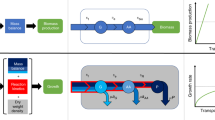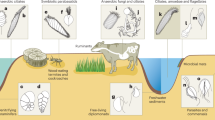Abstract
MICRO-ORGANISMS provide good experimental material in the examination of energy requirements for the growth of living matter, because the supply of energy source may be readily controlled and the amount of growth easily determined. In 1942, Monod1 reported on the growth of Bacillus subtilis, Escherichia coli and Salmonella typhimurium in a mineral medium with a wide range of carbohydrates as the source of energy. He found that, so long as the energy supply was the limiting factor for growth, the dry weight of the organisms produced (that is, growth) under anaerobic condition was proportional to the weight of the source of energy added. These findings were confirmed by DeMoss, Bard and Gunsalus2. A comparison of the growth yields of different microorganisms was recently made by Bauchop and Elsden3 on the basis of dry weight produced per mole of adenosine triphosphate (ATP) formed during the catabolism of the energy-yielding substrates (Yield CoefficientATP or YATP). In their experiments, which were also conducted under energy-limiting and anaerobic conditions, they found a striking agreement in the YATP for a number of organisms, including Streptococcus faecalis, Saccharomyces cerevisiae and Pseudomonas lindneri. The mean of 8 values for YATP is 10.5 g dry cells per mole of ATP (range, 8.3–12.6).
This is a preview of subscription content, access via your institution
Access options
Subscribe to this journal
Receive 51 print issues and online access
$199.00 per year
only $3.90 per issue
Buy this article
- Purchase on Springer Link
- Instant access to full article PDF
Prices may be subject to local taxes which are calculated during checkout
Similar content being viewed by others
References
Monod, J., Recherches sur la croissance des cultures bactériennes (Librairie scientifique, Paris, 1942).
DeMoss, R. D., Bard, R. C., and Gunsalus, I. C., J. Bact., 62, 488 (1951).
Bauchop, T., and Elsden, S. R., J. Gen. Microbiol., 23, 457 (1960).
Gunsalus, I. C., and Shuster, C. W., in The Bacteria, edit. by Gunsalus, I. C., and Stainer, R. Y., 2, 1 (Academic Press, New York, 1961).
White, J., Yeast Technology (Chapman and Hall, Ltd., London, 1954).
Chen, S. L., Biochim. Biophys. Acta, 32, 470 (1959).
Olson, B. H., and Johnson, M. J., J. Bact., 57, 235 (1949).
Sperber, E., Arkiv Kemi, Mineral. Geol., 21, A, No. 3 (1945).
Fruton, J. S., and Simmonds, S., General Biochemistry (John Wiley and Sons, New York, 1959).
Marr, A. G. (personal communication). As an alternative, if all the carbon of glucose which does not appear in cells is assumed to be oxidized with equal efficiency to carbon dioxide, the YATP should be equal to 9.13 g/mole of ATP. After correcting the energetic demand of monomer synthesis, the YATP rises to 9.73/mole of ATP.
Marr, A. G. (personal communication). In view of Senez's results (Bact. Rev., 26, 95; 1962), this value may be 6 per cent higher, if an amino-acid-containing complex medium is used.
Author information
Authors and Affiliations
Rights and permissions
About this article
Cite this article
CHEN, S. Energy Requirement for Microbial Growth. Nature 202, 1135–1136 (1964). https://doi.org/10.1038/2021135b0
Issue Date:
DOI: https://doi.org/10.1038/2021135b0
This article is cited by
-
Utilization of citrate byLeuconostoc mesenteroides subsp.cremoris in continuous culture
Biotechnology Letters (1990)
-
Energetics of the budding cycle of Saccharomyces cerevisiae during glucose limited aerobic growth
Archiv f�r Mikrobiologie (1969)
Comments
By submitting a comment you agree to abide by our Terms and Community Guidelines. If you find something abusive or that does not comply with our terms or guidelines please flag it as inappropriate.



